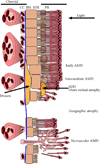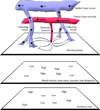A Revised Hemodynamic Theory of Age-Related Macular Degeneration
- PMID: 27423265
- PMCID: PMC4969140
- DOI: 10.1016/j.molmed.2016.06.009
A Revised Hemodynamic Theory of Age-Related Macular Degeneration
Abstract
Age-related macular degeneration (AMD) afflicts one out of every 40 individuals worldwide, causing irreversible central blindness in millions. The transformation of various tissue layers within the macula in the retina has led to competing conceptual models of the molecular pathways, cell types, and tissues responsible for the onset and progression of AMD. A model that has persisted for over 6 decades is the hemodynamic, or vascular theory of AMD progression, which states that vascular dysfunction of the choroid underlies AMD pathogenesis. Here, we re-evaluate this hypothesis in light of recent advances on molecular, anatomic, and hemodynamic changes underlying choroidal dysfunction in AMD. We propose an updated, detailed model of hemodynamic dysfunction as a mechanism of AMD development and progression.
Copyright © 2016 Elsevier Ltd. All rights reserved.
Figures




Similar articles
-
Choroidal neovascularization in transgenic mice expressing prokineticin 1: an animal model for age-related macular degeneration.Mol Ther. 2006 Mar;13(3):609-16. doi: 10.1016/j.ymthe.2005.08.024. Epub 2005 Nov 2. Mol Ther. 2006. PMID: 16263331
-
An Update on the Hemodynamic Model of Age-Related Macular Degeneration.Am J Ophthalmol. 2022 Mar;235:291-299. doi: 10.1016/j.ajo.2021.08.015. Epub 2021 Sep 9. Am J Ophthalmol. 2022. PMID: 34509436
-
Morphometric analysis of the choroid, Bruch's membrane, and retinal pigment epithelium in eyes with age-related macular degeneration.Invest Ophthalmol Vis Sci. 1996 Dec;37(13):2724-35. Invest Ophthalmol Vis Sci. 1996. PMID: 8977488
-
Mechanisms of age-related macular degeneration and therapeutic opportunities.J Pathol. 2014 Jan;232(2):151-64. doi: 10.1002/path.4266. J Pathol. 2014. PMID: 24105633 Review.
-
Age-Related Macular Degeneration: Role of Oxidative Stress and Blood Vessels.Int J Mol Sci. 2021 Jan 28;22(3):1296. doi: 10.3390/ijms22031296. Int J Mol Sci. 2021. PMID: 33525498 Free PMC article. Review.
Cited by
-
Generation of an immortalized human choroid endothelial cell line (iChEC-1) using an endothelial cell specific promoter.Microvasc Res. 2019 May;123:50-57. doi: 10.1016/j.mvr.2018.12.002. Epub 2018 Dec 18. Microvasc Res. 2019. PMID: 30571950 Free PMC article.
-
Asian age-related macular degeneration: from basic science research perspective.Eye (Lond). 2019 Jan;33(1):34-49. doi: 10.1038/s41433-018-0225-x. Epub 2018 Oct 12. Eye (Lond). 2019. PMID: 30315261 Free PMC article. Review.
-
Oral Delivery of a Tetrameric Tripeptide Inhibitor of VEGFR1 Suppresses Pathological Choroid Neovascularization.Int J Mol Sci. 2020 Jan 9;21(2):410. doi: 10.3390/ijms21020410. Int J Mol Sci. 2020. PMID: 31936463 Free PMC article.
-
Reticular Pseudodrusen Status, ARMS2/HTRA1 Genotype, and Geographic Atrophy Enlargement: Age-Related Eye Disease Study 2 Report 32.Ophthalmology. 2023 May;130(5):488-500. doi: 10.1016/j.ophtha.2022.11.026. Epub 2022 Dec 6. Ophthalmology. 2023. PMID: 36481221 Free PMC article.
-
Choroidal Vascular Impairment in Intermediate Age-Related Macular Degeneration.Diagnostics (Basel). 2022 May 22;12(5):1290. doi: 10.3390/diagnostics12051290. Diagnostics (Basel). 2022. PMID: 35626445 Free PMC article.
References
-
- Wong WL, et al. Global prevalence of age-related macular degeneration and disease burden projection for 2020 and 2040: a systematic review and meta-analysis. Lancet Glob Health. 2014;2(2):e106–e116. - PubMed
Publication types
MeSH terms
Grants and funding
LinkOut - more resources
Full Text Sources
Other Literature Sources
Medical

